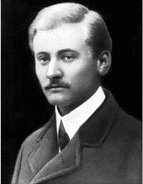 |
Fridrikh A. Tsander
The term "visionary" is used too frequently, but Fridrikh Arturovich Tsander was the genuine article. Born to an ethnically German Lithuanian family, Tsander became enthusiastic about spaceflight at a young age and was a driving force behind the creation of GIRD in 1931. He died in 1933, but his unique pioneering research was highly inspirational to the young Soviet rocket movement.
Tsander produced numerous seminal papers on the problems of space propulsion, including one of the first to suggest use of solar sails for interplanetary travel, as well as calculations on rocket propulsion theory, and even, according to one source, a proposal for a system to lift and propel an aircraft by using superconducting coils to react with the Earth's magnetic field.
 |
The rocket that eats itself. As early as 1911, Tsander described a winged "self-consuming rocket" that would take the idea of structural efficiency to its ultimate limits. Since much of the mass of a rocket consists of fuel and the containers needed to hold it - a fact that made many early rocket theoreticians doubt that large orbital rockets would ever be feasible - Tsander proposed building the rocket out of light metals that themselves could be consumed in the rocket engine as the vehicle climbed into space. Tsander's schematic drawing shows how this would be accomplished. Starting as a winged airplane using propellers for takeoff power, the spacecraft would fly from a runway and climb high into the atmosphere, accelerating as it went. At a certain point the rocket engine would be activated and the wings would be gradually retracted into the fuselage to reduce drag. As this occurred, the now-redundant portions of the wings would be fed into the combustion chamber of the rocket, lightening and accelerating the vehicle, which could now use a much smaller set of wings for lift. The process would continue as the landing gear, propellers and their drive systems, and the remaining aerodynamic surfaces went into the engine for fuel. Finally, even the unneeded portions of the rocket's body structure would be compacted and burned, until only the bare components needed for space flight remained, and the vehicle would reach orbit as a compact, very light vehicle.
|
Beginning below is a portion of a Tsander paper on theoretical and experimental work he did in 1928 on "self-consuming materials" for use as rocket fuels and structural materials. The paper was published by GIRD in 1937 in the journal "Raketnaya Teknika."
Particularly noteworthy is Tsander's mention of the possible use of alloys called "Elektron" and "Magnallium" as rocket construction materials and propellants. Elektron is a magnesium-copper alloy, typically about 85% magnesium/15% copper. Magnallium is an alloy of aluminum and about 5% magnesium. One engineering reference guide states that
though weak and soft in the elemental state, magnesium alloys with aluminum, manganese, zinc, tin, zirconium, and cerium to produce alloys useful in engineering materials. The strength and hardness of aluminum increases when it is alloyed with such substances as magnesium, manganese, nickel, chromium, zinc, iron, copper, and silicon. Magnalium -lighter and more workable than aluminum- is used in making metal mirrors and scientific instruments.
 |
 |